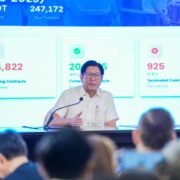An overseas Filipino votes online

When I registered for overseas voting last year at a consular outreach program in Bonn, Germany, I had a clear picture of how I would cast my ballot come election season. I would receive my ballot in the mail, shade the circle next to my pick of senators and party list, seal my ballot in an envelope, and drop it off in a postbox. At least that was how I knew it was going to be.
Reality was different. I cast my vote on my laptop on the 21st of April from the comfort of my bed. No paper, pen, stamps, or a trip to the post office required. Just my device and a stable connection.
The Commission on Elections (Comelec) determined that internet voting be the voting method for some 7,900 Filipino voters in Germany. This system has also been implemented for the first time in 76 other diplomatic outposts of the Philippines. Meanwhile, 16 other outposts will use automated counting machines. There are about 1.2 million registered Filipino overseas voters this year, and those who will vote online have until May 12, 7 p.m. (Philippine time) to do so.
The Comelec previously said that one of the reasons that internet voting was implemented was to address the low voter turnout abroad. The election body said one of the reasons for this is that voters have to take time off from work to vote. For many people, no work means no pay. The last polls saw the highest turnout of international voters at 40.59 percent of 1.6 million voters.
Step-by-step guide
The option to vote online is a way to encourage voters to exercise their constitutional right without sacrificing work. I liked the idea of convenience. In 2022, I waited some four hours to vote, so the promise of a swift and easy process was tempting. But like many people abroad, I was also skeptical. Is it safe? Is it secure? Will the system count my ballot correctly? I had many reasons not to trust this process, but I was also very motivated to make my vote count.
On April 7, I received an email from the Consulate in Frankfurt informing me of the voting method, along with a step-by-step guide and the deadline to vote. There were two steps to voting. The first step was to enroll—which required ID verification and log-in registration, followed by the next step, the actual voting.
In the enrollment, I first had to check if I was on the voters list. I clicked on the link provided by the consulate and was redirected to the certified list registered under the Philippine consulate in Frankfurt. My name was there, along with 4,035 others.
I then moved on to the actual registration on ov.comelec.gov.ph/enroll, where I created an account, received a one-time password, captured the information page of my passport, and took a photo of myself. After confirming my information on display, I immediately received an email that I had successfully enrolled for the elections.
Even though I am not knowledgeable about codes and stuff, I had some basic expectations of security features for online voting, one being the one-time password, and another, the ID verification. The online voting system ticked off the items on my thin list.
The enrollment process took three minutes, and I could cast my vote already. But I didn’t vote right away. There were 62 candidates for senator, and I wanted to get to know them as best as I could. I found useful resources from Rappler and GMA News, which had basic information on the candidates. This was an important starting point because the pages included their personal and professional backgrounds.
It took me around three days to research the candidates, and I’m glad I took my time. Overseas voters can only take their pick for national posts, so I wanted to make sure that I voted for candidates whose values closely aligned with mine.
During these days of research, I received an automatic email from the voting system reminding me to cast my vote.
‘Correctly cast’
When I felt ready, I cast my vote on April 21. I logged on to ov.comelec.gov.ph/vote and entered my credentials. There was a security feature, a one-time password that I had to enter, before getting to the landing page. The platform had two language options, English and Filipino.
The page displayed “2025 Philippine National Elections-Overseas” along with the note “not voted.” When I started the process, the instructions were first displayed before I could see my actual ballot. I picked 12 names for senators and, as soon as I selected the maximum number, the names were grayed out. I selected one party list and proceeded to review my vote.
When I finished reviewing, there was a pop-up that asked me to confirm, adding that once I cast my ballot, I would no longer be able to alter my vote. I hit submit once again and was informed that my ballot had been tendered, along with an ID that’s supposed to verify that my ballot “was correctly cast.”
Curious, I checked my ballot. That’s when I saw a bunch of codes that I could not decipher. They looked similar to the codes posted by some overseas Filipino workers who claimed that the online voting was rigged, as the ballot displayed the names of candidates they did not actually vote for.
The Comelec had earlier refuted this, adding that the codes were encrypted and would only be translated to “human-readable language” at the end of the election period. This is apparently a mechanism to prevent vote buying (makes sense). Curious again, I fed a small portion of the code to an AI software and was told that the codes did not show the fields marked as voted, and only a decrypted or decoded version could confirm my votes.
So, I’ll be checking my ballot once more when the polls are officially closed, both on the system and the consulate where I am registered. That’s what I did in 2022—check the results in my precinct—and I’ll perform the same due diligence again this time, albeit online.




















